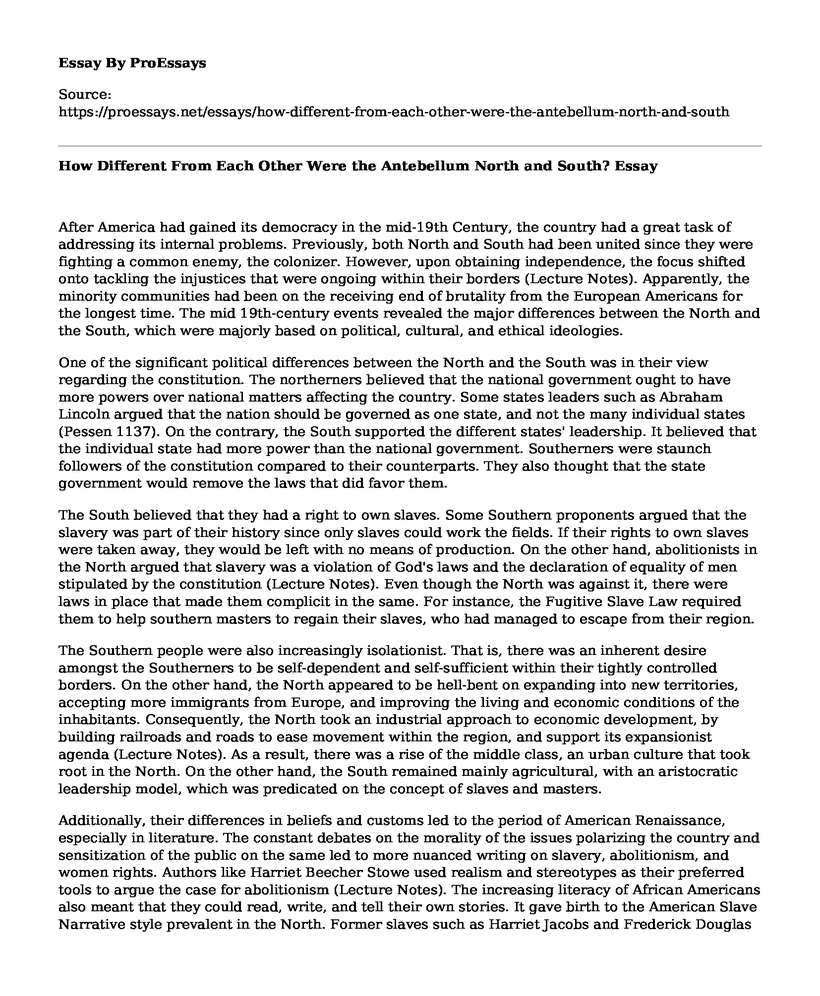After America had gained its democracy in the mid-19th Century, the country had a great task of addressing its internal problems. Previously, both North and South had been united since they were fighting a common enemy, the colonizer. However, upon obtaining independence, the focus shifted onto tackling the injustices that were ongoing within their borders (Lecture Notes). Apparently, the minority communities had been on the receiving end of brutality from the European Americans for the longest time. The mid 19th-century events revealed the major differences between the North and the South, which were majorly based on political, cultural, and ethical ideologies.
One of the significant political differences between the North and the South was in their view regarding the constitution. The northerners believed that the national government ought to have more powers over national matters affecting the country. Some states leaders such as Abraham Lincoln argued that the nation should be governed as one state, and not the many individual states (Pessen 1137). On the contrary, the South supported the different states' leadership. It believed that the individual state had more power than the national government. Southerners were staunch followers of the constitution compared to their counterparts. They also thought that the state government would remove the laws that did favor them.
The South believed that they had a right to own slaves. Some Southern proponents argued that the slavery was part of their history since only slaves could work the fields. If their rights to own slaves were taken away, they would be left with no means of production. On the other hand, abolitionists in the North argued that slavery was a violation of God's laws and the declaration of equality of men stipulated by the constitution (Lecture Notes). Even though the North was against it, there were laws in place that made them complicit in the same. For instance, the Fugitive Slave Law required them to help southern masters to regain their slaves, who had managed to escape from their region.
The Southern people were also increasingly isolationist. That is, there was an inherent desire amongst the Southerners to be self-dependent and self-sufficient within their tightly controlled borders. On the other hand, the North appeared to be hell-bent on expanding into new territories, accepting more immigrants from Europe, and improving the living and economic conditions of the inhabitants. Consequently, the North took an industrial approach to economic development, by building railroads and roads to ease movement within the region, and support its expansionist agenda (Lecture Notes). As a result, there was a rise of the middle class, an urban culture that took root in the North. On the other hand, the South remained mainly agricultural, with an aristocratic leadership model, which was predicated on the concept of slaves and masters.
Additionally, their differences in beliefs and customs led to the period of American Renaissance, especially in literature. The constant debates on the morality of the issues polarizing the country and sensitization of the public on the same led to more nuanced writing on slavery, abolitionism, and women rights. Authors like Harriet Beecher Stowe used realism and stereotypes as their preferred tools to argue the case for abolitionism (Lecture Notes). The increasing literacy of African Americans also meant that they could read, write, and tell their own stories. It gave birth to the American Slave Narrative style prevalent in the North. Former slaves such as Harriet Jacobs and Frederick Douglas became fixtures in the literature world through the narrations of their experiences. On the contrary, Southern literature was limited to journals, newspapers, fiction, and short stories. No great emphasis was put on literature compared to the North.Conclusion
In conclusion, it is clear that there was a vast chasm between the North and the South based on some particular beliefs and principles. The southerners believed in independence, slavery, among other aspects. On the contrary, the northerners were a bit accommodative and discouraged any form of slavery in the region. This gap in ideologies and the unwillingness to compromise were responsible for the Civil War.
Works Cited
Lecture Notes. "Mid-Late 19th Century Emerging and Divisive Issues: Unit 7 Lecture."
Pessen, Edward. "How Different from Each Other Were the Antebellum North and South?" The American Historical Review, vol. 85, no. 5, 1980, pp. 1119-1149.
Cite this page
How Different From Each Other Were the Antebellum North and South?. (2022, Mar 29). Retrieved from https://proessays.net/essays/how-different-from-each-other-were-the-antebellum-north-and-south
If you are the original author of this essay and no longer wish to have it published on the ProEssays website, please click below to request its removal:
- Impacts of First and Second World War to the America Society Essay
- Compare and Contrast Essay on the Declaration of Independence and the Declaration of Rights and Sentiments
- Terry Fox's Contribution to the Research for Cancer Treatment Paper Example
- George Washington's Three Departments: The Start of Political Rivalry - Essay Sample
- Essay Example on the Forgotten 500: The Greatest Rescue Mission of WWII
- Paper Example on Harriet: The Fight for Freedom and Liberation
- Essay Example on Down & Out: The 1930s Great Depression Letters of Hope







